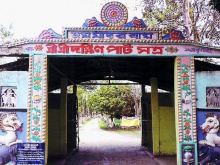
The Ahom King, Jayadwaj Singha respected Shri Vanamalidev very much. The Ahom King, Jayadwaj Singha allotted Shri Vanamalidev the land on the Southern Bank of Lohit River and this Sattra was built under royal supervision. The prestige and affluence of this Sattra was further enhanced during the reign of Chakradhaja Singha, Udayaditya Singha and Ratnadhwaja Singha.
The Dakhinpat Sattra is located along the northern bank of the Brahmaputra River. An earthen embankment is located along the southern edge of the property. This embankment protects the Island from flood and it also acts as the approach road for the Sattra. The Sattra campus extends over a large area. The entire area can be broadly classified under two categories, the core area and the green buffer area, around the core area. The land form of the core area is flat and is placed on a relatively higher elevation as compared to the immediate surrounding. The core area of this Sattra accommodates all the activities related to religious, administrative and day to day life of the Sattra. It comprises of a prayer hall, locally called as "Namghar", residential units for devotees known as "Hati", entrance gate known as "Batcora", store rooms known as "Bharal ghar", museum, store room for artifacts, library, guest house, cow sheds, ponds, open spaces for daily activities (located at the front and rear side of the Hatis) and small kitchen gardens. The buffer area of this Sattra predominantly consists of wet lands, grazing lands and forests. Most of the parts of the buffer area are covered with thick vegetation, aquatic plants and grass. Dense bamboo grooves and forest of mixed plant species are located at the Northern and Eastern side of the core area. Thick vegetation is located along the edges of the core area to create a natural buffer for the Sattra complex. The buffer zone of this Sattra supports and helps maintain the bio-diversity of this area. It attracts a huge number of migratory birds every year. A significant part of the buffer zone is maintained as grazing land by the Sattra administration. These grazing lands are accessible to the animals of the Sattra as well as of the adjoining villages. Any kind of construction activity is strictly barred in this area.
OCCUPANTS OF THE SATTRA AND THEIR RESPONSIBILITIES:
The occupants of the Sattra can be broadly classified in to two categories the Sattradhikar and the Bhakts. The Sattradhikar is the religious and the administrative head of the Sattra and all the devotees who stays permanently with in the Sattra are known as Bhakts. They are responsible for different kinds of duties related to the Sattra activities. These duties varies from administrative, maintenance, religious, and religious cum cultural activities.
